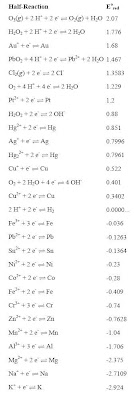
Monday, September 29, 2008
Sunday, September 28, 2008
Standard Electrode Potentials
There are several potential bench marks in common use, but the most ancient is the half-cell in which hydrogen gas is bubbled over a platinum electrode immersed in a solution having a known concentration of hydrogen ions.
This historically important reference electrode is called the standard hydrogen electrode (SHE) if a standard solution of acid is used. "By definition" the equilibrium potential of this electrode is zero at any temperature." The SHE is also called by many "normal hydrogen electrode" (NHE) in reference to a solution containing one equivalent of protons. Strictly speaking, one must use unit activity rather than concentration of hydrogen ions and unit fugacity rather than unit pressure of hydrogen gas.
However, the SHE can be somewhat inconvenient to use because of the need to supply hydrogen gas. Therefore, other reference electrodes are much preferred for practical considerations. The potential difference across a reversible cell made up of any electrode and a SHE is called the reversible potential of that electrode, E. If this other electrode is also being operated under standard conditions of pressure and concentration, then the reversible potential difference across the cell is the standard electrode potential E0 of that electrode.
Tables of standard electrode potentials in either alphabetical order or by decreasing potential values can be obtained if any one electrode, operated under standard conditions, is designated as the standard electrode or standard reference electrode with which other electrodes can be compared.
Since an electrochemical reaction can be written either as an oxidation or a reduction causing confusion in relation to the sign of the potential of that reaction, a convention was adopted in Stockholm in 1953 to write the standard potential of a reaction in reference to its reduction (E0red) as shown again in a Table listing Standard-state reduction half-cell potentials in either alphabetical order or by decreasing potential values
Standard-state reduction half-cell potentials in alphabetical order
Standard-state reduction half-cell potentials by decreasing order of potential.





